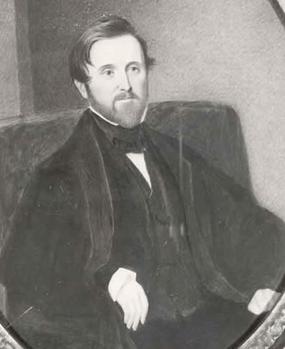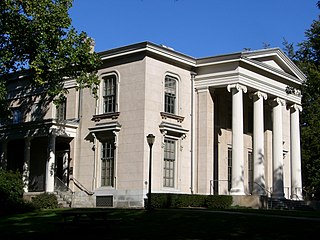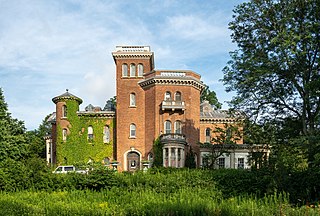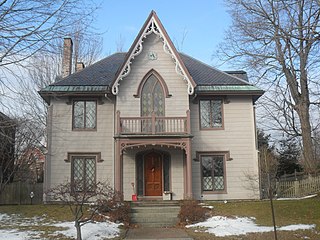
Alexander Jackson Davis was an American architect known particularly for his association with the Gothic Revival style.

Hillhouse Avenue is a street in New Haven, Connecticut, famous for its many nineteenth century mansions, including the president's house at Yale University. Both Charles Dickens and Mark Twain have described it as "the most beautiful street in America." Much of the avenue is included in the Hillhouse Avenue Historic District, which extends to include houses on adjacent streets.

Blandwood Mansion is a historic house museum at 447 West Washington Street in Greensboro, North Carolina. Originally built as a four-room Federal style farmhouse in 1795, it was home to two-term North Carolina governor John Motley Morehead (1841-1844) under whose ownership it was transformed into its present appearance. It is believed to be the oldest extant example of the Italian Villa Style of architecture in the United States, and was designated a National Historic Landmark in 1988. In creating the design for Blandwood, architect Alexander Jackson Davis produced a popular prototype for American house designs in the Italianate style: a central tower projecting from the main facade. Saved from demolition in 1964 by preservation-minded Greensboro citizens, the house was opened as a museum in 1976 and remains open to the public today.

Montgomery Place, now Bard College: The Montgomery Place Campus, near Barrytown, New York, United States, is an early 19th-century estate that has been designated a National Historic Landmark. It is also a contributing property to the Hudson River Historic District, itself a National Historic Landmark. It is a Federal-style house, with expansion designed by architect Alexander Jackson Davis. It reflects the tastes of a younger, post-Revolutionary generation of wealthy landowners in the Livingston family who were beginning to be influenced by French trends in home design, moving beyond the strictly English models exemplified by Clermont Manor a short distance up the Hudson River. It is the only Hudson Valley estate house from this era that survives intact, and Davis's only surviving neoclassical country house.

Locust Grove is a National Historic Landmark estate located on US 9 in the Town of Poughkeepsie, New York. The 200-acre park-like estate includes homes, a carriage house, ice house, trails, a flower garden, and vegetable garden, and it overlooks the Hudson River from a bluff. The property includes a home designed by architect Alexander Jackson Davis for Samuel F. B. Morse, the inventor of the telegraph. An Italianate style mansion, it was completed in 1851.

The Reuel E. Smith House located at 28 West Lake Street in Skaneateles, New York is a picturesque house designed by Alexander Jackson Davis, and later modified by Archimedes Russell. It was built during 1848–1852 and is a "good example of the Gothic Revival mode, which was a reaction against the stringencies of the Greek Revival style" as exemplified by the nearby Richard DeZeng House. It is the only house designed by Davis in Onondaga County that has survived since the demolition of the Charles Sedgewick Cottage on James Street in Syracuse.

Litchfield Villa, or "Grace Hill", is an Italianate mansion built in 1854–1857 on a large private estate now located in Prospect Park, Brooklyn, New York City. It is located on Prospect Park West at 5th Street. The villa was designed by Alexander Jackson Davis, America's leading architect of the fashionable Italianate style, for railroad and real estate developer Edwin Clark Litchfield.
Leland Castle is a building in New Rochelle, New York. It was constructed during the years in 1855 - 1859 in the Gothic Revival style, and was the country residence of Simeon Leland, a wealthy New York City hotel proprietor. Leland began to assemble an estate as early as 1848, and in 1855, began the erection of this palatial 60-room mansion. The home was designed by New York City architect William Thomas Beers. A north and south wing were added to the castle in 1899 and 1902 respectively.

The Rochelle Park–Rochelle Heights Historic District is a historic residential district located in the city of New Rochelle in Westchester, New York. The district is historically and architecturally significant as an intact and distinctive example of residential park development at the turn of the Twentieth Century. It includes the historic Rochelle Park development, and the later Rochelle Heights subdivision. Within the district are 555 contributing properties, including 513 buildings, 38 structures, and 4 sites. Only 24 buildings and 1 site separately identified within its area are non-contributing. It was listed on the National Register of Historic Places (NRHP) on July 6, 2005.

The Lispenard–Rodman–Davenport House is a historic residence dating back to the early 18th century located on the Davenport Neck peninsula in New Rochelle, New York. The house is the oldest residential structure in New Rochelle. It was listed on the National Register of Historic Places in 1986.

Richardson-Bates House is a historic home located at Oswego in Oswego County, New York. It is constructed primarily of brick and built in two stages. The main section is a 2+1⁄2-story, Tuscan Villa style brick residence with a gable roof and 4-story tower designed by architect Andrew Jackson Warner about 1867. The interior features carved woodwork by Louis Lavonier. The South wing addition included a private library, formal dining room and kitchen that was completed in 1889.

Ross-Hand Mansion is a historic home located at South Nyack in Rockland County, New York. The land was acquired from the Tallman family in 1856 by Azariah Ross (1787-1878). Ross was a veteran of the War of 1812 and a successful New York City property developer. He was a longtime resident of Rockland County, having moved there in about 1820. The design of the Mansion is closely based on a design for 'A Country House in the Pointed Style' from the Architecture of Country Houses: including designs for cottages, farm-houses, and villas, with remarks on interiors, furniture, and the best modes of warming and ventilating by the great landscape designer and architect Andrew Jackson Downing. The three story brick mansion with Gothic Revival style features was completed in 1859. It features ornamental bargeboards and a steeply pitched gable roof.

Echo Lawn Estate, also known as Stonegate after the Great War, is a historic estate located at Balmville in Orange County, New York. The main house was built about 1860 and is a two-story brick dwelling in the Second Empire style. It features sweeping concave mansard-type roofs. Also on the property is a cluster of mid-19th-century service buildings, an early 20th-century formal garden, and a substantial set of Arts and Crafts inspired gateposts and stone walls.

The Davenport House, also known as Sans-Souci, is an 1859 residence in New Rochelle, New York, designed by architect Alexander Jackson Davis in the Gothic Revival style. The "architecturally significant cottage and its compatible architect-designed additions represent a rare assemblage of mid-19th through early 20th century American residential design". The house was listed on the National Register of Historic Places in 1980.
Lawton House may refer to:

St. Katherine's Historic District is located on the east side Davenport, Iowa, United States and is listed on the National Register of Historic Places. It is the location of two mansions built by two lumber barons until it became the campus of an Episcopal girls' school named St. Katharine's Hall and later as St. Katharine's School. The name was altered to St. Katharine-St. Mark's School when it became coeducational. It is currently the location of a senior living facility called St. Katherine's Living Center.

The Gothic House, also known as the John J. Brown House, is an historic house at 387 Spring Street in Portland, Maine. Built in 1845, it is one of Maine's finest and earliest known examples of Gothic Revival architecture. Although it is virtually unaltered, it was moved down Spring Street in 1971 to avoid demolition. It was listed on the National Register of Historic Places in 1974.

The Loudoun House, located in Lexington, Kentucky, is considered one of the largest and finest examples of Gothic Revival architecture in the state. Designed by New York architect Alexander Jackson Davis, the house was built in 1851 for Francis Key Hunt (1817–1879), who was named after his mother's cousin, Francis Scott Key.

Winyah Park was the 300-acre country estate of Colonel Richard Lathers, located in the village of New Rochelle, Westchester County, New York, upon which a number of 19th-century Gothic villas and cottages designed by Alexander Jackson Davis were built. It was in 1848, after a brief but successful business career in New York, that, attracted by the accessibility and the natural environment of New Rochelle, Colonel Richard Lathers purchased a large country estate and farm along the New Rochelle and Pelham border. Three years later, in 1851, Lathers employed his personal friend and renowned architect Alexander Jackson Davis to design him a more seemly and dignified residence than the old farmhouse which existed. Revolutionizing the traditional single-house form that dominated colonial and early 19th-century domestic architecture, Davis was creating many of the country's finest villas and cottages in an entirely new, purely American style. The residence designed for Lathers was the landmark brick and marble Italian villa "Winyah", named for Lathers former estate in Winyah Parish, South Carolina.
Stuart Perry and William Swezey Houses, are two historic homes located at Newport in Herkimer County, New York. They were built in the late 1840s to plans by Alexander Jackson Davis. They are largely identical Italian Villa style, asymmetrical plan, masonry dwellings. They consist of a hipped roof block, centrally placed tower, and gable ended block.






















